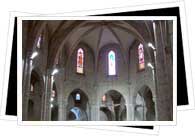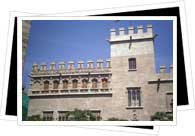Gothic Architecture in Valencia, Spain
 Gothic Architecture in Spain
Gothic Architecture in Spain
Gothic architecture in Spain directly followed Moorish and Romanesque architecture- two styles that coexisted in different parts of the country. The Christianization of formerly Moorish strongholds- particularly in the south, where some lasted well into the 15th century- naturally sparked a major makeover of practically every facet of life: religion, art, government and, of course, architecture. Many cities skipped right over Romanesque architecture, making Gothic architecture their first post-Islamic Christian architectural style. Dazzling Spain between the 13th and 15th centuries, Gothic architecture is a style boasting mainly English and French stylistic elements- at least until uniquely Spanish characteristics were increasingly thrown into the mix.
Gothic Architecture Characteristics
Gothic architecture made its mark principally in religious and civil structures. Differing greatly from the solid, bulky Romanesque structures, architects sought to create open space and achieve great heights. The airy atmosphere resulting from this new trend- both in religious and civil architecture- was complemented by the utilization of grand windows to let in tons of natural light. Thinner walls and more elegant elements- columns, moldings, windows- led to a style known both for its elegance and decorative splendor.
Aside from these basic elements of Gothic architecture, in many religoius structures you can find smaller chapels spread around the periphery of the church or cathedral, a detail that allowed for simultaneous celebrations and quiet areas of prayer. A few uniquely Spanish elements added to this otherwise English and French-inspired style were the inclusions of a cloister, a Spanish favorite, and the positioning of the coro (an elaborate set of choir stalls) right in the main nave. Windows that come to a point as well as giant altarpieces, generally carved and multi-colored, are two other Gothic characteristics, and in Cataluña you can find large square or octagonal towers.
In Gothic civil structures, in addition to the achievement of space, height and light of the Gothic style in general, you will find that they often bear resemblance to fortification-like structures complete with battlements, molded coats of arms, etc.
 Gothic Architecture in Valencia
Gothic Architecture in Valencia
Walking around Valencia, you're likely to run into endless examples of stunning Gothic architecture. Perhaps the best example of Gothic architecture in Valencia is the Lonja de los Mercaderes; in fact, many experts believe it to be the best example of Gothic civil architecture in all of Europe! From the outside, the incredible structure looks exactly like a medieval castle straight from a fairy tale, complete with battlements, a tower, pointed windows, gargoyles, and exemplary Gothic exterior adornment. Inside, you'll immediately notice the airy, spacious atmosphere created by its many windows as well as its elegant columns that raise spectacular vaults nearly 16 meters high!
In the El Carmen district, you'll find the two surviving gateways of the medieval wall that once encircled the city. Looking up at the Torres de Serrano and Torres de Quart, focus on their battlements and fortification-like appearance- telling signs of their Gothic origins.
Heading from the Torres de Serrano southward brings you to the Cathedral, another top-notch example of Gothic architecture. Its layout with smaller chapels around the periphery, its octagonal tower, its two stories of enormous windows leading up to the dome and the Puerta de los Apóstoles are just a few of the Cathedral's many Gothic elements.
